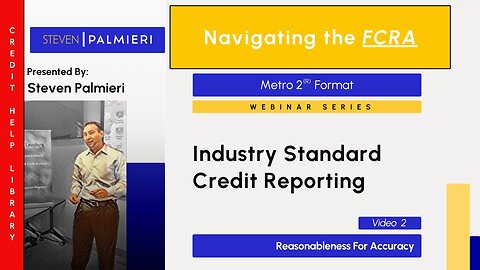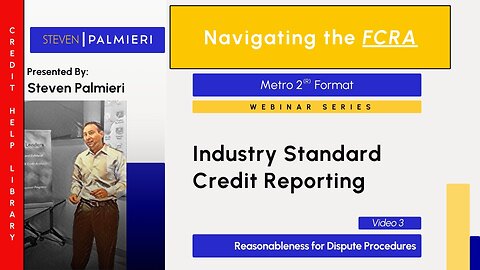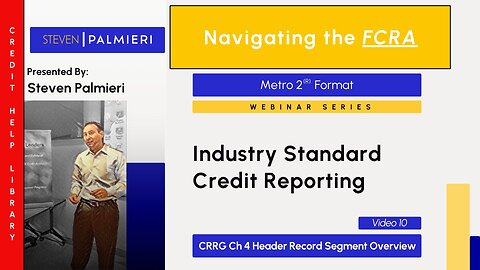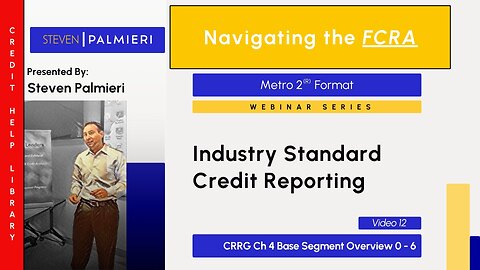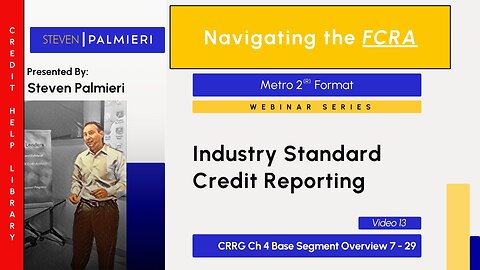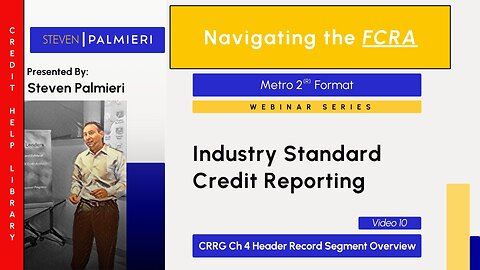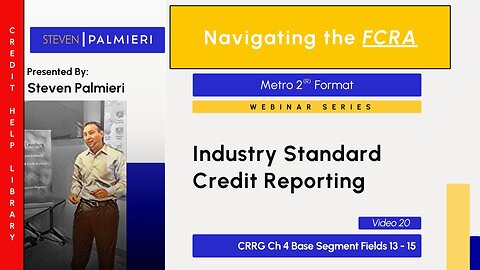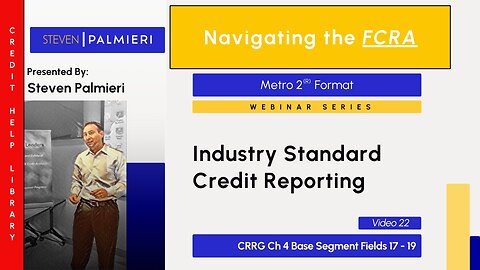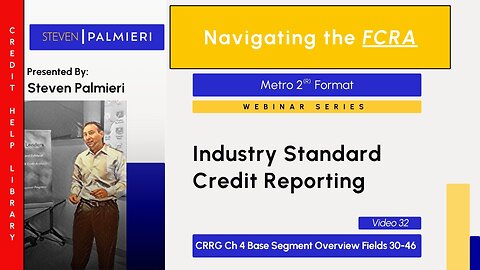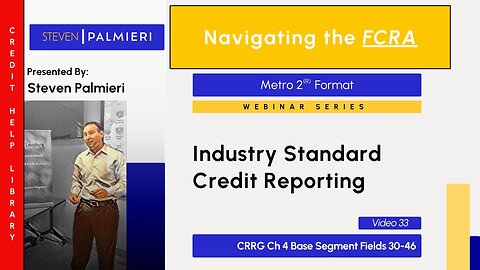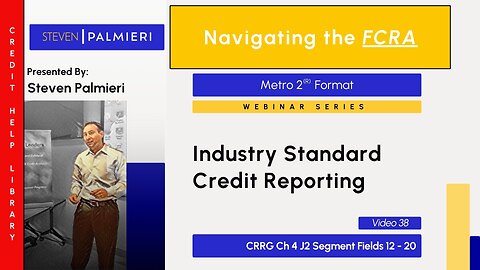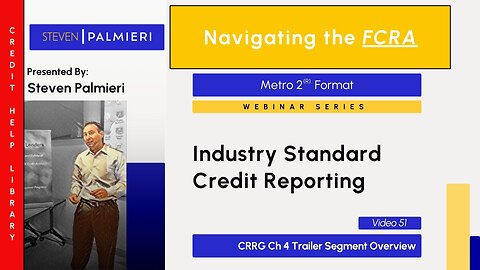Premium Only Content

What is an Industry Standard
Reasonableness for Accuracy
Reasonableness for Dispute Procedures
Metro 2 Table of Contents
Ch 1 Overview
Ch 2 Overview
Ch 3 Overview
Ch 4 Overview
Ch 4 Segment Overview
Ch 4 Header Record Segment Overview
Ch 4 Base Segment Overview
Ch 4 Base Segment Overview Fields 0 - 6
Ch 4 Base Segment Overview Fields 7 - 29
Ch 4 Base Segment Field 7
Ch 4 Base Segment Field 8
Ch 4 Base Segment Field 9
Ch 4 Base Segment Field 10
Ch 4 Base Segment Field 11
Ch 4 Base Segment Field 12
Ch 4 Base Segment Fields 13 - 15
Ch 4 Base Segment Field 16
Ch 4 Base Segment Field 16
Ch 4 Base Segment Fields 17 - 19
Ch 4 Base Segment Field 20
Ch 4 Base Segment Field 21
Ch 4 Base Segment Field 22
Ch 4 Base Segment Field 23
Ch 4 Base Segment Field 24
Ch 4 Base Segment Field 25
Ch 4 Base Segment Field 26
Ch 4 Base Segment Field 27
Ch 4 Base Segment Field 28
Ch 4 Base Segment Overview 30 - 46
Ch 4 Base Segment Fields 30 - 46
Ch 4 J1 Segment Overview
Ch 4 J1 Segment Fields 1 - 12
Ch 4 J2 Segment Overview
Ch 4 J2 Segment Fields 1 - 11
Ch 4 J2 Segment Fields 12 - 20
Ch 4 K1 Segment Overview
Ch 4 K1 Segment Fields 1 - 3
Ch 4 K2 Segment Overview
Ch 4 K2 Segment Fields 1 - 4
Ch 4 K3 Segment Overview
Ch 4 K3 Segment Fields 1 - 4
Ch 4 K4 Segment Overview
Ch 4 K4 Segment Fields 1 - 6
Ch 4 L1 Segment Overview
Ch 4 L1 Segment Fields 1 - 5
Ch 4 N1 Segment Overview
Ch 4 N1 Segment Fields 1 - 9
Ch 4 Trailer Segment Overview
Ch 5 Overview
Ch 5 Exhibit 1 - 2
Ch 5 Exhibit 3
Ch 5 Exhibit 4
Ch 5 Exhibit 5
Ch 5 Exhibits 6 - 7
Ch 5 Exhibit 8
Ch 5 Exhibit 9
Ch 5 Exhibit 10
Ch 5 Exhibit 11
Ch 5 Exhibits 12 - 16
Ch 6 Overview
Ch 7 Overview
Ch 8 Overview
Ch 9 - 13 Summary
Ch 9 Overview
Ch 10 Overview
Ch 11 Overview
Ch 12 Overview
Ch 13 Overview
Ch 14 Overview
Ch 2 Overview
The video summarizes Chapter 2 of the Metro 2 Credit Reporting Resource Guide, explaining how Metro 2 serves as a critical link between the Fair Credit Reporting Act’s (FCRA) "reasonable procedures" requirement and the goal of "maximum possible accuracy" in credit reporting. This chapter, titled "Automated Data Reporting," highlights Metro 2 as an industry standard accepted by all consumer reporting agencies (CRAs) and compliant with all applicable federal and state laws, not just the FCRA. It ensures data integrity and consistency, mandating that furnishers report all accounts at least monthly—a key point for readers to note when spotting errors, as non-monthly reporting violates Metro 2’s own guidelines under the "Industry Reporting Standards" section.
Chapter 2 also includes quick reference guides with charts tailored to specific credit types, such as banking, installment loans, child support, credit cards, debt buyers, mortgages, student loans (federal and private), and utility accounts. These guides help standardize reporting across industries. For readers aiming to read credit reports accurately, identify errors, and draft dispute letters to CRAs, Chapter 2 provides a foundation: they can use Metro 2’s monthly reporting requirement and consistency standards to challenge incomplete or inconsistent data, citing the industry’s own rules as evidence of inaccuracies.
-
 20:22
20:22
Real Estate
8 days ago $3.72 earnedNumber 1 Indicator Home Prices ARE ABOUT TO CRASH
9.64K2 -
 30:09
30:09
Afshin Rattansi's Going Underground
18 hours ago‘Gaza Will Haunt Israel for Generations’- Mika Almog Granddaughter of Former President Shimon Peres
10.7K6 -
 15:36
15:36
Nikko Ortiz
13 hours agoBring Back Public Shaming...
13.7K7 -
 2:43:41
2:43:41
Side Scrollers Podcast
19 hours agoAsmongold Says The Online Left Are “ANIMALS” + Hasan Collar-Gate Gets WORSE + More | Side Scrollers
20.9K16 -
 1:33:41
1:33:41
Dinesh D'Souza
2 days agoThe Dragon's Prophecy Film
89.7K58 -
 LIVE
LIVE
Lofi Girl
2 years agoSynthwave Radio 🌌 - beats to chill/game to
353 watching -
 44:08
44:08
The Why Files
6 days agoThe CIA, Men in Black and the Plot to Take Out JFK | The Maury Island Incident
53.7K67 -
 2:07:23
2:07:23
TimcastIRL
10 hours agoTrump SLAMS China With NEW 100% Tariff, Stocks & Crypto TUMBLE | Timcast IRL
302K161 -
 5:15:25
5:15:25
SpartakusLIVE
11 hours agoBF6 LAUNCH DAY || WZ and BF6 followed by PUBG - The PERFECT Combo?
66.1K3 -
 1:33:59
1:33:59
Glenn Greenwald
13 hours agoQ&A with Glenn: Is the Gaza Peace Deal Real? Why was the Nobel Peace Prize Given to Venezuela's Opposition Leader? And More... | SYSTEM UPDATE #529
121K73

